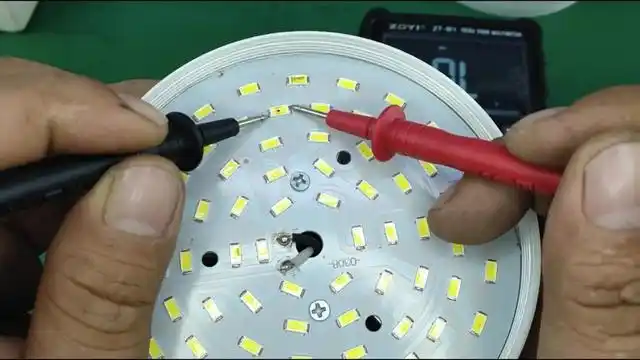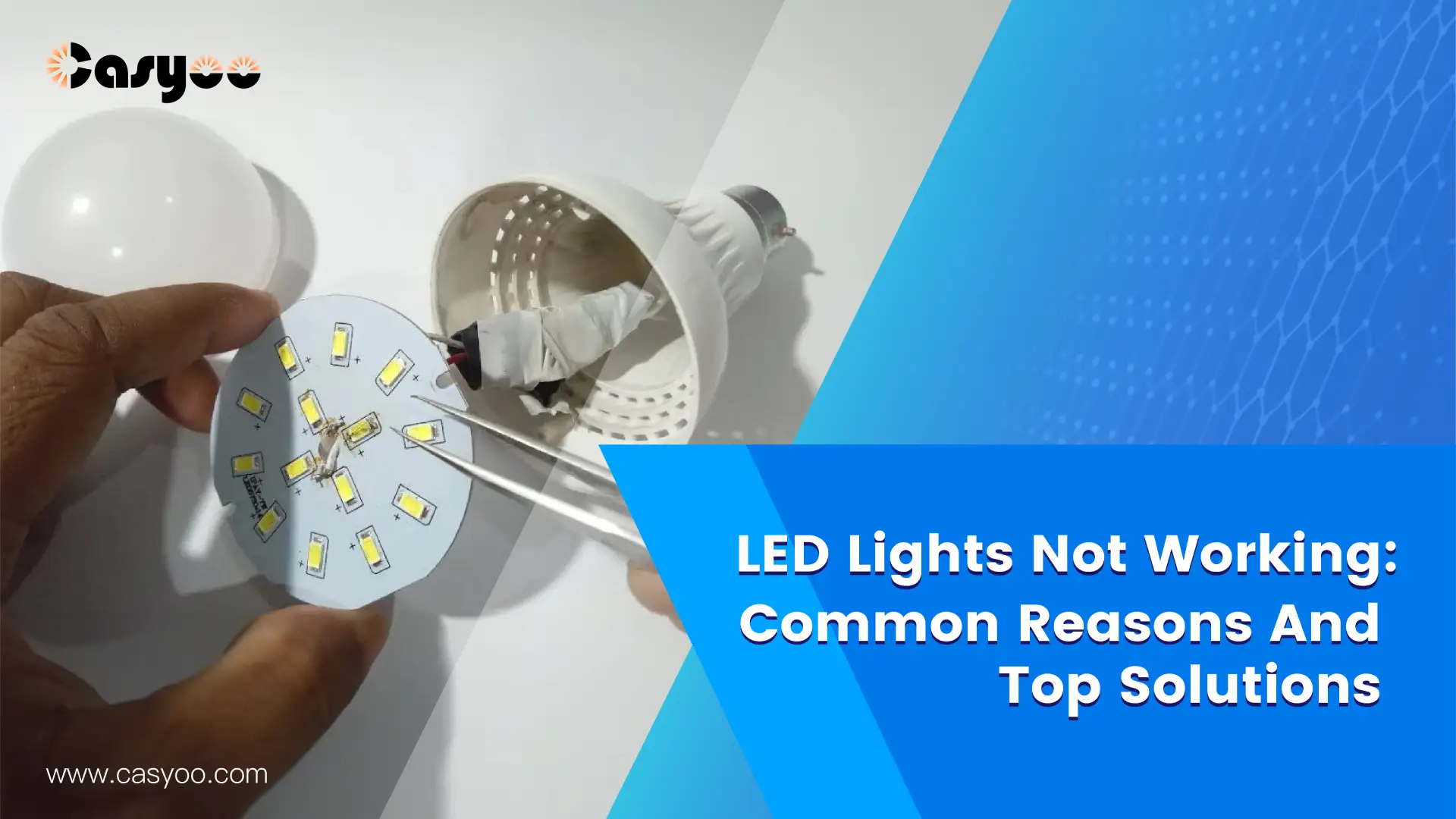When an LED light suddenly stops working, is your first reaction to replace it with a new one? But sometimes the problem is not only related to the LED light. In this article, we will analyze the causes and solutions of the following LED failures. After reading this article, you will master practical tips to solve the problem of LED lights not working by yourself!
- LED lights completely stops working despite having power
- Only some LEDs light up while others remain dark
- Flickering issues that create an unstable lighting effect
- LEDs emit a faint glow even when switched off
- overheating problems that may shorten the lifespan of the LED
LED lights not working but has power
- The positive and negative poles of LED lights have been inverted. In general, the voltage measured after reversing the connection is the no-load voltage. If this is the case, reconnect the LED light by reversing its positive and negative poles.
- The output terminal wire is not securely attached. This is equivalent to an open circuit for the LED light, and the tested voltage will be reported as the no-load voltage. You need to reconnect the output terminals.
- The real load does not match the power output. LED driving circuits may fail if the real power is higher or lower than the rated power.
- A short or open circuit will make the LED light unable to light up. In this case, contact a professional to fix the circuit.
- LED light beads can burn out over time, just like other electronic components. If the issue is not due to the power supply or circuit, check if the light break down. One method is to do “comparison testing” by comparing suspected faulty lamp beads to normal ones.
-
Issues with the driver or capacitor: LED lights won’t work normally if the driver or capacitor is not compatible with them. Another possibility is the capacitor or LED driver failure. If the driver fails, its output voltage often can not meet the voltage output required by the lamp. If the capacitor fails, there may be bulging, leakage of electrolyte or scorch marks on it. Moreover, the capacitance value will not be within the rated range. In this case, you should replace the driver or the capacitor. When replacing the driver, choose a power supply that corresponds to the LED lamp. When replacing the capacitor, choose the one with the same specification as the original or a higher withstand voltage value.

Only half of my LED lights are working, why?
Individual lamp bead failures in LED light modules will not influence other lights, but will cause the lights to dim. Common reasons for their faults include:
- Moisture: Moist LED lamp beads fail to illuminate or are insufficiently bright. This is a common storage issue with LED lamp beads. Producers normally will help customers bake them a second time before they can be used again.
- Damage: A burned lamp bead will show a black spot on its surface. If only one or two lights are broken, order the same type and replace them. If there are a considerable number of damaged lamp beads, you should replace the board.
LED light strips are usually divided into sections. The lights in each section are connected together in a series, and the sections are connected in parallel. If one of the lights in a section burns out, it will make the section stop working. In this scenario, you can modify or cut away the unlit section.
Why are my LED lights flickering?
- If the LED light and driver specs do not match, the bulb may not be able to withstand high current, causing the light to flicker. how to fix LED lights that flicker due to compatibility issues? Replace an appropriate driver for the lamp.
- After using the LED bulb for some time, the driver is likely to fail. Changing a new driver may help fix the problems with LED lights.
- If the driver has an over-temperature protection function, it will protect the circuit in cases where the LED lights have poor heat dissipation. This causes the light to flicker. If so, you should improve the lights’ heat dissipation capabilities by modifying the casing, adding heat dissipation components, and so on.
- LED lights can flicker if they are used in a moist environment. Over time, the moisture can damage the light and the driver. If your driver is waterproof, you can replace the LED light.
-
Incompatible dimmer: If you use a typical dimmer, it may not work with LED lights, causing them to flicker. In this case, you should choose a dimmer specifically for LEDs, which often supports low-power lights, does not interfere with the driver, and has a wide adjustment range.
-
Voltage fluctuations: LED lights that experience frequent voltage changes or an unreliable power supply may flicker. You can install a voltage stabilizer or choose a higher quality LED driver.
How to deal with LED ghosting?
LED ghosting means that the LED light will still emit weak light after being turned off. The reasons for LED ghosting and the ways to solve it are:
- One common reason is that the switch is wired incorrectly. The switch should control the live wire, not the neutral wire. When the switch is turned off, the lamp that is connected to the live wire will emit a faint light. The solution is to change the wiring so that the switch controls the live wire.
- Some LED lights are made with cheap components that can cause problems. For example, some lights use low-quality drivers that can leak electricity, which can cause the light to flicker or stay on even when it is turned off. Also, copper cladding substrates and capacitance effects can both induce light leakage. You need to purchase new lights of guaranteed quality.
- Some LED lights have electronic switches with indicator lights. These lights can stay on even when the switch is turned off because a small amount of electricity is still flowing through the switch. Changing the switch or connecting a resistor in parallel to the lamp’s incoming line are the two possible solutions.
What to do with LED lights overheating?
LED lights can overheat for a number of reasons, including poor design, high temperatures, and other factors. Here are some aspects you can consider to solve the problem of LED lights overheating:
- First, optimize the heat dissipation design. When purchasing LED lights, you can select products with superior heat dissipation designs, such as those with aluminum alloy heat sinks and large-area heat dissipation holes. During the installation procedure, keep the lamp at a set distance from the wall or other objects to aid in heat dissipation. Heat dissipation design is especially important for outdoor LED lights like LED street lights.
- Second, keep the ambient temperature under control. When installing LED lights, try to avoid placing them in direct sunlight or in high-temperature enclosed spaces. If the temperature is high, try employing cooling equipment like air conditioners or fans to decrease it.
- In addition, regular lamp cleaning is an efficient strategy to reduce heat generation. Dust and debris on the lamp’s surface will reduce heat dissipation, so cleaning the lamp is necessary.
How do you reset LED lights?
There is usually a reset button on the LED light strip controller. After 5-10 seconds of pressing and holding the reset button, the LED light will begin to flash. After the reset, the LED light strip will change into its original color. Another way to reset is to disconnect the power supply and wait 10-15 seconds before reconnecting.
For smart LED bulbs, you can reset them on the corresponding application. You should refer to the manual for details since different brands of lights may have different reset methods.
Frequently asked questions
Q: How to troubleshoot an LED light?
A: Check the power connection first when your LED light fails to operate. Check the bulb for discoloration and possible physical damage. For continued troubleshooting, evaluate the bulb by testing it through a separate fixture before obtaining a new bulb to confirm the issue.
Q: How do I know if my LED is blown?
A: When an LED bulb experiences failure it will completely stop emitting light or exhibit intermittent flickering and develop noticeable burnt areas on its surface. You can also use a multimeter to verify whether the LED maintains continuous flow. If the bulb fails these checks, it is likely blown.
Q: Why do LED lights keep failing?
A: The insufficient thermal control of LED lights may cause both system overheating and accelerated product degradation. LED lights can fail because of both abnormal electrical voltage conditions and installation problems and defects in manufacturing.
Conclusions
In the above passage, we have discussed common faults of LED lights, which include LED lights not working, flickering, ghosting, and overheating. We have also mentioned some useful tips for troubleshooting LED lights by yourself. But still, for some operations, you need to ask professionals for help. Casyoo is always here for you when you encounter any troublesome problems with LED lights and need new ones. Contact us now!




